Well, I managed to catch the flu Christmas eve and have been too tired to do much. But this week I am jumping into the project again. Gotta close that ceiling cause it's getting really cold.
How Much to Wire Small Bathroom
- Thread starter vinny11950
- Start date
-
Active since 1995, Hearth.com is THE place on the internet for free information and advice about wood stoves, pellet stoves and other energy saving equipment.
We strive to provide opinions, articles, discussions and history related to Hearth Products and in a more general sense, energy issues.
We promote the EFFICIENT, RESPONSIBLE, CLEAN and SAFE use of all fuels, whether renewable or fossil.
You are using an out of date browser. It may not display this or other websites correctly.
You should upgrade or use an alternative browser.
You should upgrade or use an alternative browser.
- Status
- Not open for further replies.
Still coughing some but getting through the work.
The other morning, early morning it was 20 degrees outside, when I went up the sky light window and saw a few drips of water running down the framing. Since it didn't rain, I am assuming condensation and some deal of sun radiation causing it to condense because it does not do it other times.
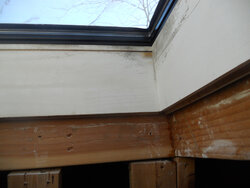
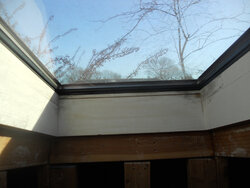
Maybe this explains the mold stains on the frame. I plan to sand it down and use a mold resistant paint. Can't see doing anything about the condensation though.
The other morning, early morning it was 20 degrees outside, when I went up the sky light window and saw a few drips of water running down the framing. Since it didn't rain, I am assuming condensation and some deal of sun radiation causing it to condense because it does not do it other times.


Maybe this explains the mold stains on the frame. I plan to sand it down and use a mold resistant paint. Can't see doing anything about the condensation though.
Last edited by a moderator:
Went a little overboard with the foam insulation.
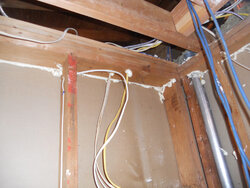
Dry fit the toilet one last time just to make sure I don't get any surprises when finished. 12 inch rough. The toilet I bought is a Kohler for a 12 inch rough, and you still have about an inch to play with between the water tank and the back of the wall.
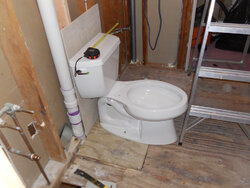
Got the Fantech inline fan installed, rated for 190 cfm. It is a 4 inch fan, but I used 6 inch duct. I had to go with the 4 inch exhaust fan because the vent from the roof is 4 inch, a Broan vent hood that is sold in HD. I hate it. 4 inch doesn't carry much air and if you add in other factors, can really kill your cfm (if you have a choice when installing a new vent through the roof, go with 6 inch). But I wasn't about to climb the roof in winder and learn to how drill a 6 inch hole in the roof. So I used a 6 inch Speedi boot register, a 90 degree elbow and insulated flex duct, into a T and then a 6 inch to 4 inch reducer. I plan to add another smaller duct to the other side of the T, that will draw air from the skylight well if I keep getting mold issues. I will cap it for now.
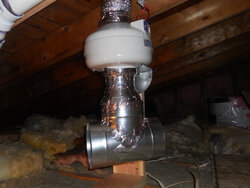
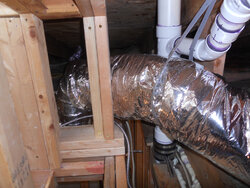
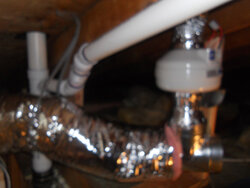
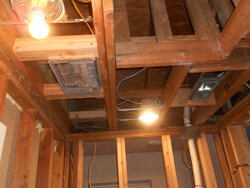
Got the ceiling heater installed. It puts out a lot of heat very quickly. Fashioned a chain to hold it up so it doesn't pull on the wire.
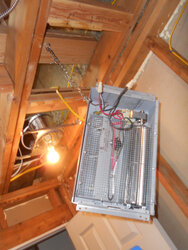

Dry fit the toilet one last time just to make sure I don't get any surprises when finished. 12 inch rough. The toilet I bought is a Kohler for a 12 inch rough, and you still have about an inch to play with between the water tank and the back of the wall.

Got the Fantech inline fan installed, rated for 190 cfm. It is a 4 inch fan, but I used 6 inch duct. I had to go with the 4 inch exhaust fan because the vent from the roof is 4 inch, a Broan vent hood that is sold in HD. I hate it. 4 inch doesn't carry much air and if you add in other factors, can really kill your cfm (if you have a choice when installing a new vent through the roof, go with 6 inch). But I wasn't about to climb the roof in winder and learn to how drill a 6 inch hole in the roof. So I used a 6 inch Speedi boot register, a 90 degree elbow and insulated flex duct, into a T and then a 6 inch to 4 inch reducer. I plan to add another smaller duct to the other side of the T, that will draw air from the skylight well if I keep getting mold issues. I will cap it for now.




Got the ceiling heater installed. It puts out a lot of heat very quickly. Fashioned a chain to hold it up so it doesn't pull on the wire.

Last edited by a moderator:
Also added more insulation and replaced torn insulation in the attic. Very time consuming. Not as exciting so no pictures.
Have to figure out how I am going to air seal the ceiling heater. Maybe I will do one of those foam boxes in the above attic space.
Have to figure out how I am going to air seal the ceiling heater. Maybe I will do one of those foam boxes in the above attic space.
Last edited:
Buzz Saw
Minister of Fire
Is the sky light insulated?
No.
But what exactly should be insulated? All the way up to the roof sheathing?
Thanks.
Buzz Saw
Minister of Fire
If the sides of the sky light are exposed to a cold space,like an attic, there will be condensation like you are experiencing. The cold side of the sky light should be insulated from the cold. Foam board and spray foam would be my first choice.No.
But what exactly should be insulated? All the way up to the roof sheathing?
Thanks.
If the sky light isn't exposed to cold air then I'm not sure how to help ya. The pic makes me think it is exposed to cold air.
Hope that made sense.......
If the sides of the sky light are exposed to a cold space,like an attic, there will be condensation like you are experiencing. The cold side of the sky light should be insulated from the cold. Foam board and spray foam would be my first choice.
If the sky light isn't exposed to cold air then I'm not sure how to help ya. The pic makes me think it is exposed to cold air.
Hope that made sense.......
Yes, thank you.
semipro
Minister of Fire
The glass on our bathroom skylight gathers a lot of condensation and has to do with the glazing temp rather than the frame temp.
The only possible solution I can think of is to install an additional glass or plastic barrier just below the level of the ceiling within the skylight.
This would decrease condensation through the additional R-value or at least allow any condensation forming to drop off onto the floor below rather than draining down the side of you skylight and maybe the ceiling.
The only possible solution I can think of is to install an additional glass or plastic barrier just below the level of the ceiling within the skylight.
This would decrease condensation through the additional R-value or at least allow any condensation forming to drop off onto the floor below rather than draining down the side of you skylight and maybe the ceiling.
The only possible solution I can think of is to install an additional glass or plastic barrier just below the level of the ceiling within the skylight.
That's a great idea, Semipro. Had not thought of it. Thanks.
Whoever framed this house, had trouble getting the studs 16 on center. The cool thing about Roxul is that you can cut a piece to fit the difference and compress them in between the studs and it holds tight.
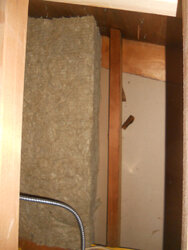
Here is a picture of the smaller bathroom fittings for the sink. This is the other side of the bathtub wall. I like using the 1/2 inch male threaded copper fitting with the 1/4 turn female threaded water supply valve - 2 adjustable wrenches allows you to crank them tight with no issues. Should make replacing them easy, no soldering under the sink.
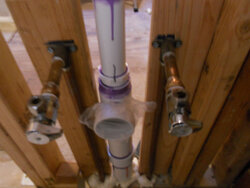
Here is the underside of the Speedi boot register. I added the 6 inch damper and tested it a few times to make sure it opens cleanly. No issues.
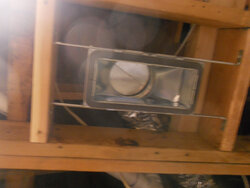

Here is a picture of the smaller bathroom fittings for the sink. This is the other side of the bathtub wall. I like using the 1/2 inch male threaded copper fitting with the 1/4 turn female threaded water supply valve - 2 adjustable wrenches allows you to crank them tight with no issues. Should make replacing them easy, no soldering under the sink.

Here is the underside of the Speedi boot register. I added the 6 inch damper and tested it a few times to make sure it opens cleanly. No issues.

Last edited by a moderator:
fbelec
Minister of Fire
i didn't understand where is the 6 to 4 inch reducer? most fans if you reduce the pipe it speeds up the fan and shortens the life of the fan motor.
i didn't understand where is the 6 to 4 inch reducer? most fans if you reduce the pipe it speeds up the fan and shortens the life of the fan motor.
Yes, sorry, that part is confusing. I put the reducer right before the fan. I hope the centrifugal fan is strong enough to take the strain. But I put the 6 inch duct because it makes for easier air flow. I figure it is easier to change a burnt out fan than upgrading an undersized duct run that is buried in the narrow slope of the attic. Might as well go big or go home.
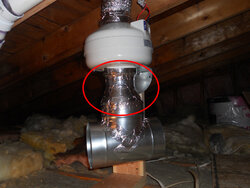
Last edited by a moderator:
fbelec
Minister of Fire
Yes, exactly. I was reading through the HVAC forums and everyone pretty much hates the 4 inch roof hood vents (which was installed years ago) because they are not big enough to get the required CFM. Home Depot should sell them with a disclaimer that they may not work as well as desired.
So I am trying to make up for it by using the 6 inch duct run and a powerful 4 inch fan. If the 4 inch fan is not enough, I can upgrade to the 6 inch fan rate for 267 CFM. Since the fan is installed in the tall part of the attic, it's not that difficult.
So I am trying to make up for it by using the 6 inch duct run and a powerful 4 inch fan. If the 4 inch fan is not enough, I can upgrade to the 6 inch fan rate for 267 CFM. Since the fan is installed in the tall part of the attic, it's not that difficult.
From the little I can see, he's not taking much pride in his work.
Well, sadly Burnham was correct. I kept looking at the wires in the boxes and finally pulled them all out and figured out what he did. He did 3 things that made me undo some of the work and redo it right from what I could figure out on the electrical forums.
1) What bothered me at first was a multibranch wire circuit he ran for the small bathroom and the large bathroom using 12/2 AC wire lite - Black hot fed large bathroom, white became hot for the small bathroom (on a separate breaker) and green wire became the neutral - for ground wire he tapped into the ground for the separated circuit for the dedicated bathroom electric heater. No reason for this with new wiring. At least he should have used 12/3 wire. Also he didn't use a double pole breaker for the two circuits so they trip together. And no, the metal clad was not the grounding type with the bonding strip.
2) I guess he got confused with what I asked and left a 240 volt wire from another circuit in the box. No reason for it. (I had to remove the wire from the feed in the attic).
3) And finally, he tied the neutrals from different circuits together. A definite no no.
So I pulled a new 12/2 romex wire from the panel box, to the attic, and made that the feed to the small bathroom. This allowed me to change the multibranch wire to a regular circuit to feed the big bathroom. Much more simple to follow and wire safely.
Then this made separating the neutrals straight forward, keeping them to their circuits only. Interestingly enough, once I straightened this out my AM radio signal got much clearer. Turns out connecting neutrals from different circuits can cause EMFs which mess with AM radio reception.
On the plus side of doing this is I now understand the wiring much better. And I only zapped myself twice. Had to learn all this on the fly.
Anyway, this took 2 days to sort out and a lot of bitching. Funny thing was buying the Romex 12/2 wire. 50 feet of wire is like $25. Saw that I could get 250 feet for $50 but what the hell am I going to do with 250 feet of wire. Well, the 50 feet ran out and I had to get more wire, so I ended up buying the 250 anyway!
Buzz Saw
Minister of Fire
Always buy that 250' roll. Never know when you might need to run another circuit, or help a buddy do some wiring.
The other day I bought a 1000' roll cheaper than 4-250' rolls.....I only have a few spare feet.....About 200' spare
The other day I bought a 1000' roll cheaper than 4-250' rolls.....I only have a few spare feet.....About 200' spare

I bought a 1000' roll cheaper than 4-250' rolls
I didn't even notice the 1000 roll..... You are truly all in on the wiring, Buzz Saw.
Buzz Saw
Minister of Fire
I'm in the middle of wiring my new 40x60 pole barn. I've ran ten 20 amp circuits so far and I think I'm going to run a few more since I still have extra. You can never have to many circuits, especially with lots of power tools.I didn't even notice the 1000 roll..... You are truly all in on the wiring, Buzz Saw.
Still have to run conduit for the 50amp circuits....
I'm in the middle of wiring my new 40x60 pole barn. I've ran ten 20 amp circuits so far and I think I'm going to run a few more since I still have extra. You can never have to many circuits, especially with lots of power tools.
Still have to run conduit for the 50amp circuits....
Absolutely makes sense to run separate circuits at 20 amps. Easy to switch off and isolate if you need to. Especially with copper prices now, wiring and water pipes are really affordable now. I have been getting the 12 gauge wires and the thicker L type water pipes. Go big or go home.
bag of hammers
Minister of Fire
I put radiant heat in the floor in my last bathroom build. For a couple extra $ I ran a spare thermistor in the floor as a spare. From whet i was told, as long as you don't break or damage the heat cables the odds of failure are very low (I tested the circuit 3 times before covering them). In the small bathroom I only needed @16 sq ft of heat cable / mesh with total power draw just under 200 watts). Used self leveling concrete to cover the mesh, then ditra and tile over that. Also ran a spare 14/2 over the shower for some add'l light - I think the radiant bulbs mentioned in this thread are on the radar now for that spot. In total the materials (including wall thermostat) added approx $450 to the job. I wouldn't hesitate to do another, stepping onto a warm floor in the early morning or middle of the (cool) night visits to the bathroom is really nice.I did. Just saw a friend who put it in the new bathroom he redid, but I am scared to embed electrical in the tile with no access to service or repair. Not worth it if something goes wrong I am pulling tiles.
fbelec
Minister of Fire
Vinny nice job figuring out the guy was a hack overloading neutrals could have been a fire. Also multi wire is useless cause everything has to be arc fault breakers and they don't work with 3 wire and sharing a neutral.
bag of hammers
Minister of Fire
Vinny nice job figuring out the guy was a hack overloading neutrals could have been a fire. Also multi wire is useless cause everything has to be arc fault breakers and they don't work with 3 wire and sharing a neutral.
+1 on the great job fixing the issues.
Re: arc fault, FWIW, when I wired my addition only 2 bedrooms were required to be arc fault. I had 10 circuits on standard breakers, the arc fault (Eaton) at the time were something like $70 each vs $7 for the same 15 amp. The inspector told me the high cost was a factor in the code decision at the time (limiting the requirement to bedroom circuits as it could otherwise add $1,000 or more to a job). I hope the price has come down in recent years.
Vinny nice job figuring out the guy was a hack overloading neutrals could have been a fire. Also multi wire is useless cause everything has to be arc fault breakers and they don't work with 3 wire and sharing a neutral.
Thanks, Frank.
I meant to ask before but forgot; are bathroom circuits supposed to be on arc fault breakers if they are dedicated and have GFCI protection at the switch box in the bathroom? I keep reading conflicting views on this.
the guy was a hack
Very disappointed with this outcome. The guy had done work for me before that was good. He is punctual, responsive, respectful, and a nice guy.
- Status
- Not open for further replies.
Similar threads
- Replies
- 8
- Views
- 569
- Replies
- 36
- Views
- 2K
- Replies
- 17
- Views
- 2K

